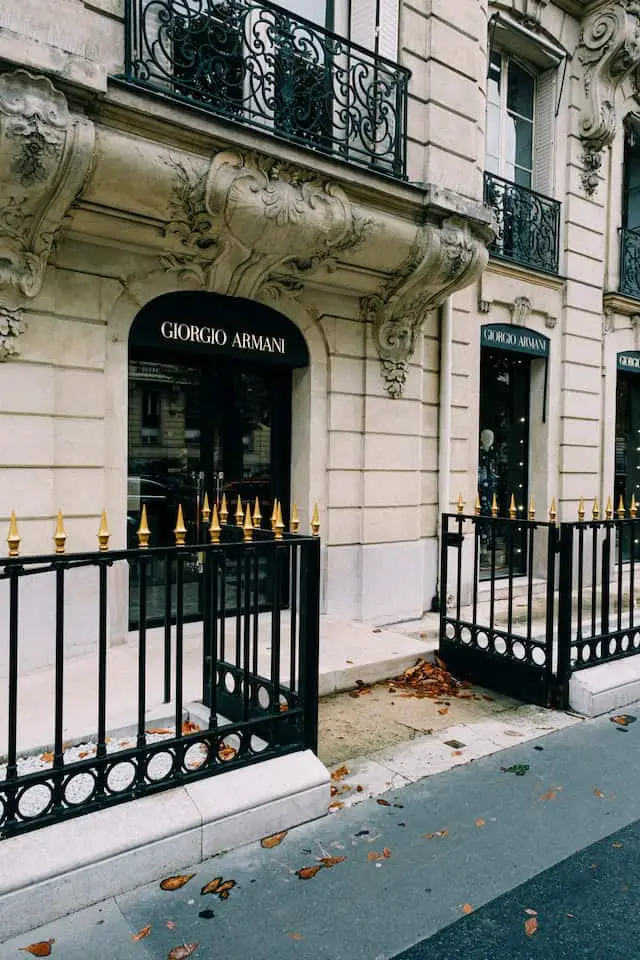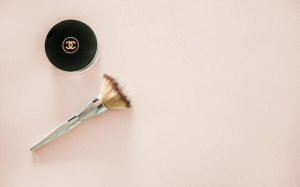Gucci and Armani are considered high-end fashion labels, with Gucci ranking first and Armani eleventh, respectively, among the most luxurious brands in the world. Founded and now led by its namesake designer, Giorgio Armani’s fashion house has achieved legendary status thanks to its groundbreaking innovations and consistently cutting-edge aesthetic. Gucci and Armani are not only one of the most valuable fashion firms in the world, but they have also become among the most well-known and respected brand names in the luxury brand market.
Armani vs Gucci- Overview
Giorgio Armani S.p.A., or Armani, is an Italian luxury fashion brand that Giorgio Armani established in 1975. Armani is known for designing, manufacturing, and retailing haute couture, accessories, ready-to-wear, leather goods, shoes, and home furnishings.
What Brands Fall Under Armani?
Armani has several brands selling different products. The brands include:
- Giorgio Armani
- Emporio Armani
- Armani Collezioni
- Armani Exchange
- Armani Junior and Armani Baby
- Armani/Casa
- Armani/Dolci
- Armani/Fiori
Luxury fashion powerhouse Gucci is headquartered in Florence, Italy, and its product categories include handbags, ready-to-wear, footwear, accessories, and home décor. It has licensed its name and trademark to Coty, Inc. for fragrance and cosmetics under Gucci Beauty. Gucci has long been a symbol of elegance and sophistication in popular culture. Gucci represents Italian craftsmanship and design internationally. This “Icon” of the luxury and fashion sector has changed considerably since its founding in 1921.
Armani History
The Armani vs Gucci debate won’t be complete without discussing the history and evolution of the two fashion powerhouses. Let’s begin with Armani’s history!
Sold a Car to Start Business
Armani and his partner and architect Sergio Galeotti founded Giorgio Armani SpA in 1975 with (supposedly) the money Armani received from selling his Volkswagen. In 1978, the firm entered a licensing agreement with Gruppo Finanziario Tessile (GFT). It entered into a licensing arrangement with L’Oreal in 1980 to produce and distribute fragrances, cosmetics, and beauty items, and Luxottica to produce and distribute eyewear in 1988. Armani, upon launching A|X Armani Exchange in 1991, also licensed manufacture and distribution to Simint. By 1993, 23 licensees and two major joint ventures in Japan were using the Armani brand.
Shifting Back to In-House Manufacturing
To better manage product quality and delivery, the corporation decided in the 1990s to stop using outside licensees and start making everything in-house. The 1990 purchase of Antinea, the 1996 purchase of Simint, and the 2007 purchase of Intai are all examples of manufacturing arrangements that were brought back in-house (1998). Armani launched a joint venture with Zegna in 2000 to produce and distribute the Collezioni men’s collection after purchasing factories from GFT. Armani also boosted its stake in its joint venture with Itochu in Japan from 80% to 85%.
Let’s Go Mega!
Starting with the Armani/Manzoni shop in Milan in 2000, which sells all of the company’s brands, Armani opened four more megastores designed by Massimiliano and Doriana Fuksas in the early 2000s. New York City’s Armani/Fifth Avenue and the Armani/Chater House in Hong Kong are just two of many such establishments worldwide. Safilo Group had the exclusive license to produce Armani-branded eyewear from 2003 until 2012, when they lost it to Luxottica again. The partnership with Samsung to create a new line of premium electronics began in 2007. Giorgio Armani told Reuters in 2007 that Beiersdorf had approached him about a merger in 2005. Supposedly, he had been preoccupied with other initiatives at the time and had not gotten around to pursuing them.
Giorgio Armani Foundation
In 2016, he confirmed setting up the Giorgio Armani Foundation to sponsor social projects and protect the Armani Group’s governance assets to remain stable. Since 2016, when “valid alternatives at our disposition that render the use of cruel practices unnecessary as regards animals” were available, the fashion house has not used any animal fur in any of its designs.
By the time 2017 rolled around, the company was widely considered ready for an IPO. Giorgio Armani decided against a merger with LVMH or Kering in 2021.
Gucci History
The Gucci brand has endured family feuds, takeover attempts, a near-bankruptcy, a public listing, storybook turnarounds, and even a murder that inspired the Ridley Scott film “House of Gucci,” starring Lady Gaga. Here’s the history behind Gucci.
How It Started
A charisma was cultivated by Guccio Gucci, who in 1897 got a job as a bellboy at London’s Savoy Hotel. The legend goes that he got the idea for his enterprise from seeing the expensive luggage carried by the hotel’s nobles. The first Gucci boutiques debuted in Florence, where the firm was founded, in 1921. Gucci started selling leather goods and travel accessories, but when the name caught on with British nobility, the company expanded into the equestrian equipment market.
In 1938, the store in Rome’s high-end Via Condotti first opened its doors. As time went on, Gucci’s sons Aldo, Vasco, and Rodolfo joined the business, helping it expand and gain a stellar reputation. Not one to give up, in 1935–1936, Gucci developed a specifically woven hemp from Naples printed with the first characteristic print: a sequence of small, interconnected diamonds in dark brown on a tan background. This helped the company sell its first wave of profitable bags.
Post War Business
After WWII, the production of leather goods restarted, and Gucci’s son Aldo developed the pigskin, which would later become the brand’s characteristic material. During this time, we expect to see the first examples of bags with bamboo handles, which take their design cues from the curve of a saddle.
Rodolfo and Alessandra Gucci gave birth to their son and company’s future leader Maurizio Gucci in 1948. Rodolfo founded the original store in 1951 on Milan’s Via Montenapoleone. About at this time, the company’s distinctive green-red-green site appeared. A forerunner of Italian fashion in America, Aldo Gucci built his first U.S. boutique in the Savoy Plaza Hotel on New York’s East 58th Street in 1953. Just 15 days after the grand inauguration of his New York store, Guccio Gucci passed away at 72. That year, Gucci debuted the loafer with the metal horsebit that would later be displayed at the Metropolitan Museum of Art in New York.
Celebrity Push
In 1955, they officially trademarked the family emblem. His sons took over the business, and Gucci remained a thriving enterprise for many years. The Horsebit loafer, with its now-iconic double ring and bar, was introduced in 1953, and stars like Elizabeth Taylor were seen wearing bamboo-handled bags.
Jacqueline Kennedy was seen with a Gucci bag in 1961, and the brand promptly christened it “The Jackie” in her honor. Similarly, it developed its iconic double-G emblem around the same time- initially intended to secure bags. It has persisted until the present day. The Flora scarf pattern was created in 1966 for Grace Kelly, the Princess of Monaco. The design has grown so recognizable that it has been used by both Frida Giannini and Alessandro Michele for their respective collections.
News Stores and Acquisitions
During the ’70s, other Gucci boutiques opened in New York City, Tokyo, and Hong Kong. When Gucci released Gucci No. 1 in 1975, they joined the fragrance market. In 1981, Gucci debuted its first ready-to-wear fashion show. The event occurred in Sala Bianca of Palazzo Pitti in Florence, Italy, and featured the ‘Flora’ pattern.
Several fundamental shifts and high drama occurred at Gucci throughout the subsequent decades. By the 1980s, Guccio’s grandchildren had joined the company’s staff, and internal strife ensued over who would succeed Guccio as CEO. Eventually, Maurizio, Rodolfo’s son, acquired control of the business and drove his cousins and uncle Aldo out. Nearly half of Gucci was purchased by a holding firm called Investcorp in 1989. Then, to revitalize the store’s reputation, they hired Dawn Mello as president and Richard Lambertson as head of accessories at Bergdorf Goodman.
Enters the Master
Things began to shift when Tom Ford, a young, incredibly gifted designer, entered the scene in 1990. At Gucci, he supervised the ready-to-wear line before being promoted to Creative Director in 1994. Ford is widely credited as the creative force behind Gucci’s renaissance, thanks to his incorporation of hypersexual designs and campaign imagery. The rest of Maurizio Gucci’s shares were sold to Investcorp then.
Maurizio Gucci was shot and killed on March 27, 1995, in front of his workplace in Milan. Gucci, led by CEO Domenico De Sole, and Ford, often known as the Tom and Dom Dream Team, went public on the New York and Amsterdam stock markets in the same year. Even though Gucci’s then-CEO Domenico De Sole opposed it, LVMH began to buy company shares in the late 1990s stealthily. Strategically becoming the most significant stakeholder ahead of the company’s complete takeover, investor François Pinault of Pinault Printemps Redoute (PPR) entered the picture. After rebranding as Kering in 2013, PPR still includes Gucci inside its umbrella of luxury goods brands.
Ford and De Sole Down their Tools
Ford and CEO Domenico De Sole left the firm in 2004 due to contract conflicts with PPR, but not before Ford hired Frida Giannini, formerly of rival Fendi, to work on Gucci’s accessories. Once Ford left, John Ray took over the menswear division, and Alessandra Facchinetti oversaw the women’s. A while later, Giannini was elevated to Creative Director of Accessories.
In 2006, her decision to reintroduce the ‘Flora’ pattern rather than emphasize the double-G mark paid huge dividends. In 2008, David Lynch oversaw Gucci’s debut television commercial for their Gucci by Gucci fragrance. The same year, James Franco was featured in ads for Gucci by Gucci Pour Homme, Giannini’s debut fragrance for men. Gucci’s now-iconic Flora by Gucci fragrance debuted that year.
Di Marco Leaves the Company, and Alessandro Michele Takes Over
Giannini and CEO Patrizio Di Marco suddenly announced their departure from the company in late 2014. It was subsequently revealed that Alessandro Michele, who had worked for the company for 12 years, would be taking on the role of Creative Director. Michele’s first step as Creative Director was to assist in designing a completely new menswear collection in less than a week. A month later, on the runways of Milan, he presented his first collection of womenswear, which was an immediate hit. Following Di Marco’s departure, Gucci hired Marco Bizzarri to replace him as president and CEO.
Eco-Friendly Products
For several years following his employment, Michele transformed the high-end label into its current iteration, with its penchant for printed fabrics, sequins, and oversized eyewear. Gucci released its first unisex fragrance, Mémoire D’une Odeur, and refreshed its Gucci Beauty makeup collection in 2019. Just recently, in May of 2020, Michele declared that Gucci would no longer adhere to the traditional format of Fashion Week and instead embrace year-round collections. In addition, the number of annual exhibitions would be reduced from five to two. The brand has vowed to reduce its environmental effect, including greenhouse gas emissions, by 2025, and it has gone fur-free starting with its 2022 collections.
Wrap Up
Armani and Gucci are some of the most prestigious labels in fashion. The perception of these two companies is consistent with that of luxury brands. Gucci and Armani have become two of the most recognizable and prestigious names in the luxury fashion sector. However, the ideal fashion label depends on the individual who will be donning it. That’s because both names are synonymous with superior quality and opulence.







